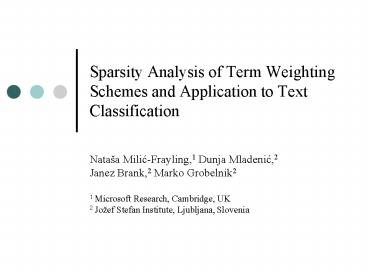Sparsity Analysis of Term Weighting Schemes and Application to Text Classification - PowerPoint PPT Presentation
1 / 14
Title:
Sparsity Analysis of Term Weighting Schemes and Application to Text Classification
Description:
Sparsity Analysis of Term Weighting Schemes and Application to Text Classification. Nata a Milic-Frayling,1 Dunja Mladenic,2. Janez Brank,2 Marko Grobelnik2 ... – PowerPoint PPT presentation
Number of Views:59
Avg rating:3.0/5.0
Title: Sparsity Analysis of Term Weighting Schemes and Application to Text Classification
1
Sparsity Analysis of Term Weighting Schemes and
Application to Text Classification
- Nataa Milic-Frayling,1 Dunja Mladenic,2 Janez
Brank,2 Marko Grobelnik21 Microsoft Research,
Cambridge, UK2 Joef Stefan Institute,
Ljubljana, Slovenia
2
Introduction
- Feature selection in the context of text
categorization - Comparing different feature ranking schemes
- Characterizing feature rankings based on their
sparsity behavior - Sparsity defined as the average number of
different words in a document (after feature
selection removed some words)
3
Feature Weighting Schemes
- Odds ratioOR(t) logodds(tc) / odds(t?c)
- Information gainIG(t c) entropy(c)
entropy(ct) - ?2-statistic?2(t) N (NtcN?t?c Nt?cNc?t)2 /
Nc N?c Nt N?tN number of all documents Ntc
number of documents from class c containing
term t, etc.Numerator equals 0 if t and c are
independent. - Robertson Sparck-Jones weightingRSJ(t)
log(Ntc0.5) (N?t?c0.5) /
(Nc?t0.5)(Nt?c0.5)(very similar to odds
ratio)
4
Feature Weighting Schemes
- Weights based on word frequencyDF document
frequency (no. of documents containing the
word this ranking suggests to use the most
common words)IDF inverse document frequency
(use the least common words)
5
Feature Weighting Schemes
- Weights based on a linear classifier (w,
b) prediction(d) sgnb Sterm ti wi TF(ti,
d) - If a weight wi is close to 0, the term ti has
little influence on the predictions. - If it is not important for predictions, it is
probably not important for learning either. - Thus, use wi as the score of a the term ti.
- We use linear models trained using SVM and
perceptron. - It might be practical to train the model on a
subset of the full training set only (e.g. ½ or ¼
of the full training set, etc.).
6
Characterization of Feature Rankings in terms of
Sparsity
- We have a reatively good understanding of feature
rankings based on odds ratio, information gain,
etc., because they are based on explicit formulas
for feature scores - How to better understand the rankings based on
linear classifiers? - Let sparsity be the average number of different
words per document, after some feature selection
has been applied. - Equivalently the avg. number of nonzero
components per vector representing the document. - This has direct ties to memory consuption, as
well as to CPU time consumption for computing
norms, dot products, etc. - We can plot the sparsity curve showing how
sparsity grows as we add more and more features
from a given ranking.
7
Sparsity Curves
8
Sparsity as the independent variable
- When discussing and comparing feature rankings,
we often use the number of features as the
independent variable. - What is the performance when using the first 100
features? etc. - Somewhat unfair towards rankings that prefer (at
least initially) less frequent features, such as
odds ratio - Sparsity is much more directly connected to
memory and CPU time requirements - Thus, we propose the use of sparsity as the
independent variable when comparing feature
rankings.
9
Performance as a function of the number of
features(Naïve Bayes, 16 categories of RCV2)
10
Performance as a function of sparsity
11
Sparsity as a cutoff criterion
- Each category is treated as a binary
classification problem (does the document belong
to category c or not?) - Thus, a feature ranking method produces one
ranking per category - We must choose how many of the top ranked
features to use for learning and classification - Alternatively, we can define the cutoff in terms
of sparsity. - The best number of features can vary greatly from
one category to another - Does the best sparsity vary less between
categories? - Suppose we want a constant number of features for
each category. Is it better to use a constant
sparsity for each category?
12
Results
13
Conclusions
- Sparsity is an interesting and useful concept
- As a cutoff criterion, it is not any worse, and
is often a little better, than the number of
features - It offers more direct control over memory and CPU
time consumption - When comparing feature selection methods, it is
not biased in favour of methods which prefer more
common features
14
Future work
- Characterize feature ranking schemes in terms of
other characteristics besides sparsity curves - E.g. cumulative information gain how the sum of
IG(t c) over the first k terms t of the feature
ranking grows with k. - The goal define a set of characteristic curves
that would explain why some feature rankings
(e.g. SVM-based) are better than others. - If we know the characteristic curves of a good
feature ranking, we can synthesize new rankings
with approximately the same characteristic curves - Would they also perform comparatively well?
- With a good set of feature characteristics, we
might be able to take the approximate
characteristics of a good feature ranking and
then synthesize comparably good rankings on other
classes or datasets. - (Otherwise it can be expensive to get a really
good feature ranking, such as the SVM-based one.)































